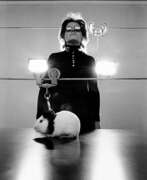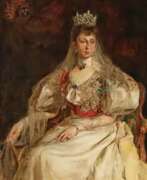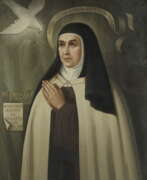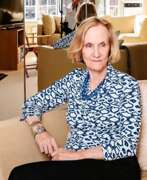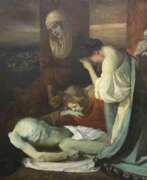Portraitist 20th century


Alexander Grigorievich Maksymenko (Russian: Александр Григорьевич Максименко) was a Soviet and Ukrainian painter of the second half of the twentieth and early twenty-first centuries. He is known as a painter, graphic artist, watercolorist, and art historian.
Alexander Maksymenko worked in the genres of still life, landscape, portrait, as well as in genre painting. His genre works cover themes of collective farm life, including "Masters of the Land" and "Innovators of Collective Farm Fields". For the latter work he received the Stalin Prize. The master actively participated in exhibitions in Ukraine and abroad. His works are in the National Art Museum of Ukraine, the Museum of the History of Ukraine in World War II, as well as in other art museums and private collections.


Herbert Ritts Jr. was an American fashion photographer and director known for his photographs of celebrities, models, and other cultural figures throughout the 1980s and 1990s. His work concentrated on black and white photography and portraits, often in the style of classical Greek sculpture, which emphasized the human shape.


Wilhelm Schmurr was a German painter and co-founder of the Sonderbund in Düsseldorf. His style, characterized by clear expression, was influenced by the Pre-Raphaelites, Symbolists, and Realists. He received several awards and medals for his work and was a member of various art associations. Schmurr taught at the Kunstakademie Düsseldorf and inspired by the farmers after the war, he created scenes of simple life and still lifes. He was awarded the Karl-Ernst-Osthaus-Preis and the Bundesverdienstkreuz erster Klasse and became an honorary member of various artist associations.


Pavel Efimovich Ab (Russian: Павел Ефимович Аб) was a Russian Soviet artist, born on November 22, 1902, in Orel. He is renowned for his contributions to painting and graphic arts, having studied under notable mentors such as Kuzma Petrov-Vodkin and A. I. Savinov at the VKhUTEIN in Leningrad during the years 1923 to 1929.
Ab's career was deeply influenced by his experiences during the Great Patriotic War, where he served in the 21st Rifle Division of the NKVD on the Leningrad Front. His war-time sketches of city defenders and subsequent military honors played a significant role in his artistic expression. After the war, he continued to actively participate in the creative community, producing notable works like "Pavlov in Koltushi" and "Speech of V. I. Lenin at the Admiralty Shipyards".
His artworks, which often depicted military and historical themes, are preserved in various museums and private collections in Russia and abroad. Ab's commitment to the Leningrad Union of Artists until his death in 1974 ensured that his legacy would influence future generations of artists.
For enthusiasts and collectors keen on exploring Russian Soviet art, staying updated on exhibitions and sales featuring Pavel Efimovich Ab's works can be enriching. Sign up here for updates related to new product sales and auction events concerning Ab's art.


Vilmos Aba-Novák was a distinguished Hungarian artist, celebrated for his unique blend of Expressionism with classical and Renaissance influences. Born in Budapest in 1894, he was deeply influenced by his experiences in the Austro-Hungarian Army during World War I, which later permeated his art. Aba-Novák is best known for his vibrant frescoes and murals that decorate several public buildings in Hungary, including churches and civic buildings in Szeged and Budapest.
His works, characterized by dynamic compositions and a bold use of color, often depicted village fairs, circuses, and everyday Hungarian life, bringing an almost fantastical quality to these scenes. His remarkable ability to combine traditional subjects with modern artistic elements made his work a significant contribution to modern Hungarian art. Aba-Novák's art was not only appreciated in his homeland but also internationally, earning him major awards like the Grand Prize at the Paris World Exhibition in 1937 and at the 1940 Venice Biennale.
For art collectors and enthusiasts interested in exploring or purchasing Vilmos Aba-Novák's works, staying informed about upcoming sales and exhibitions is crucial. Signing up for updates can provide valuable insights into available pieces and auction events. To keep abreast of such opportunities, consider registering for newsletters or alerts specifically tailored to Aba-Novák's art. This will ensure you don't miss out on acquiring a piece of this unique artistic heritage.






Berenice Alice Abbott was an American photographer best known for her portraits of between-the-wars 20th century cultural figures, New York City photographs of architecture and urban design of the 1930s, and science interpretation in the 1940s to 1960s.




Victor Ashotovich Abramyan (Russian: Виктор Ашотович Абрамян) was a Soviet and Russian artist of the second half of the twentieth and early twenty-first centuries. He is known as a painter, a representative of the Leningrad school.
Victor Abramyan created portraits, landscapes, still lifes and genre paintings. He participated in exhibitions from the early 1970s in Leningrad. Among his famous works are "Blockade everyday life", "Still Life with a Centennial", "Leningrad. 1942. Women on Guard in the besieged city", "Young Guests" and others.
Abramyan's works are in museums and private collections in Russia and many other countries.


Angelo Accardi is a contemporary Italian artist. He grew up surrounded by both modern and traditional art. Although he studied fine art at the Art Academy of Naples, he never completed his training. Angelo Accardi illustrates surreal visions of everyday life under realistic backdrops of urban and natural landscapes. There is never a single meaning, but a whole story behind each painting. Ironic, striking, and playful, Accardi’s unique perspective and avant-garde style is a result of his diverse inspirations.


Julius Anton Adam was a German genre painter and animalist who specialised in the depiction of cats and was a member of an influential family of Munich painters.
Julius Anton Adam was a pupil of Professor Michael Echter and later Wilhelm von Dietz at the Munich Academy of Art. He later became a professor himself.
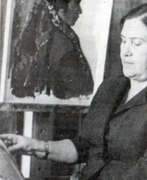

Yevgeniya Mikhailovna Adamova (Russian: Евгения Михайловна Адамова) was a Soviet artist of the second half of the twentieth century. She is known as a painter, People's Artist of the Turkmen SSR.
Yevgeniya Adamova, who moved to Turkmenistan from Ukraine in her youth, was educated at the Ashgabat Art School. During the Great Patriotic War, she creatively expressed herself as a poster artist in the TurkmenTAG agency. The artist created thematic paintings dedicated to the life of the Turkmen people and portraits. She held the post of deputy chairman of the Union of Artists of Turkmenistan.


Taisia Kirillovna Afonina (Russian: Таисия Кирилловна Афонина) was a Soviet artist of the second half of the twentieth century. She is known as a painter, graphic artist, representative of the Leningrad school.
Taisia Afonina participated in exhibitions since 1940, creating portraits, landscapes, genre compositions, still lifes and etudes. At the beginning of her career she was interested in military subjects, and then delved into the genre of portraiture and lyrical landscape. Her style is characterized by tonal painting, the rendering of light and air environments and subtle coloristic combinations. In the 1980s she preferred the watercolor technique, painting flowers such as roses, daisies and tulips. Her works are in museums and private collections in Russia and other countries.


Friedrich Ahlers-Hestermann was a German painter and art writer from Hamburg. He was a member of the Hamburgische Künstlerclub of 1897, as well as of the Hamburg artist's workshop of 1832 and pupil of the Académie Matisse in Paris. After the First World War, he was a co-founder of the Hamburg Secession.


John Ronald Craigie Aitchison was a Scottish painter. He was best known for his many paintings of the Crucifixion, one of which hangs behind the altar in the chapter house of Liverpool Cathedral, Italian landscapes, and portraits (mainly of black men, or of dogs). His simple style with bright, childlike colours defied description, and was compared to the Scottish Colourists, primitivists or naive artists, although Brian Sewell dismissed him as "a painter of too considered trifles".
His career-long fascination with the crucifixion was triggered by a visit to see Salvador Dalí's Christ of St John of the Cross in 1951 after it was acquired by the Kelvingrove Gallery.


Vladimir Ivanovich Akulov (Russian: Владимир Иванович Акулов) is a Soviet and contemporary Belarusian artist. He is known as a painter, graphic artist and teacher, a representative of the second wave of Belarusian avant-garde.
Vladimir Akulov in his work has developed a unique style under the influence of expressionism, cubism, primitivism, fauvism. He is a master of portrait, landscape, still life, compositions with symbolic and allegorical subjects, illustrations of literary works. During his career the artist created several cycles of portraits, including those of famous people.


Tamam Al-Akhal is a Palestinian artist and educator living in Jordan. She studied at the Fine Arts College in Cairo. From 1957 to 1960, she taught art at the Makassed Girls College in Beirut. In 1959, she married Ismail Shammout. Al-Akhal has exhibited in Egypt, Lebanon, Jerusalem, Jordan, the United States, Kuwait, England, China, Morocco, Berlin, Paris, Rome, and Vienna. She gave a series of lectures at the Jordan National Gallery of Fine Arts in 2009. Her art appeared on more than a dozen covers of Palestinian Affairs, a magazine published by the Palestine Liberation Organization. She was also head of the PLO's Arts and Heritage section. With her husband, she painted a series of large murals known as "Palestine: The Exodus and the Odyssey."




Ismail Al-Sheikhly is a contemporary Iraqui artist. He belonged to one of the first art groups to appear in Iraq, 'La Societe Primitive', founded in 1950. The group later changed its name to 'The Pioneers' and kept it into the 1970s. Some of his works are influenced by Cubism, a movement which grew in popularity throughout the 1950s, and was the preferred artistic style of one of Al-Sheikhly's important contemporaries, Hafiz Drubi. Al Sheikhly’s early works are inspired by the Iraqi village life, though his later works are more focused on abstracted colour combinations and obscured backgrounds. Women feature highly as a central theme in his work. Painted in groups quite often, Al Sheikhly’s women are streamlined with oval faces and generic bodies and seem to always be in states of coming and going, whether that be to the mosque, to the souks, or to do some domestic task.


Pyotr Filippovich Alberti (Russian: Пётр Филиппович Альберти) was a Soviet and Russian artist of the second half of the twentieth century. He is known as a painter, a representative of the Leningrad school.
Pyotr Alberti created portraits, landscapes, genre paintings. He actively exhibited since 1951 in Leningrad, demonstrating his works along with the masters of his time. The artist had a broad writing and bright coloring, expressive stroke and used various techniques. He paid special attention to the study of nature. In the late period of his career, he became fond of still life paintings with favorite motifs such as peonies and watermelons.
Alberti's works are preserved in museums and collections around the world.


August Allebé was an artist and teacher from the Northern Netherlands. His early paintings were in a romantic style, but in his later work he was an exponent of realism and impressionism. He was a major initiator and promoter of Amsterdam Impressionism, the artist's association St. Lucas, and the movement of the Amsterdamse Joffers. Amsterdam Impressionism – sometimes referred to by art historians as the School of Allebé – was the counterflow to the very strong Hague School in the movement of Dutch Impressionism. As a professor at the Royal Academy of Amsterdam (Rijksakademie van beeldende kunsten) he fostered a cosmopolitan attitude toward art and the promotion and motivation of his students, and provided a significant stimulus to developments in modern art.


John Altoon was an American painter and representative of Abstract Expressionism. He was an important figure in Los Angeles art in the 1950s and 1960s.
He studied at the Otis Art Institute and simultaneously attended the Los Angeles Art Centre College of Design. Known for figurative works, he was a member of the Ferus group with Edward Kienholz and Robert Irwin. He suffered from schizophrenia from an early age and in fits of depression and paranoia destroyed some of his work.


Manuel Álvarez Bravo was an Mexican visionary photographer whose work vividly illustrates the cultural heritage of Latin America. His unique perspective on life and superb photographic skills have inspired generations of photographers around the world.
Alvarez Bravo was known for his experiments with light and shadows, composition and form. His surreal photographs were often full of mystery and enigma, while also reflecting the difficulties and contradictions of Mexican society in the first half of the 20th century.
Alvarez Bravo's work marvellously combined aesthetic beauty with profound social context. His work is not only inspiring in its beauty but also a reminder of the importance of preserving peoples' cultural heritage and history.
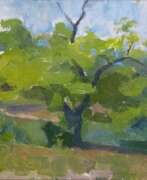



Louise Elisabeth Andrae was a German Post-Impressionist landscape painter and watercolorist. She studied with two landscape painters; Gustav Adolf Thamm in Dresden and Hans von Volkmann in Karlsruhe. She settled in Dresden, but spent long periods on the island of Hiddensee. There, she helped organize a group known as the Hiddensoer Künstlerinnenbund, an association of women artists that included Clara Arnheim, Elisabeth Büchsel, Käthe Loewenthal and Katharina Bamberg. They were regular exhibitors at an art venue known as the Blaue Scheune (Blue Barn), established in 1920 by Henni Lehmann. She also exhibited frequently with a group known as the Kunstkaten in Ahrenshoop.Wikipedia


Diane Arbus was an American photographer. Arbus's imagery helped to normalize marginalized groups and highlight the importance of proper representation of all people. She photographed a wide range of subjects including strippers, carnival performers, nudists, people with dwarfism, children, mothers, couples, elderly people, and middle-class families.


Kurt Ard was a Danish illustrator, painter and printmaker. He became internationally famous for his narrative cover artwork published in popular magazines of the 1950s-1970s, including the Family Journal, the Saturday Evening Post and Reader’s Digest. Ard started his career at various smaller newspapers and worked in the same realistic tradition as his role model, illustrator and painter, Norman Rockwell. During WW II, Kurt struggled to fulfill commission orders. His painting and his reputation and success grew steadily in the post war years. His illustrations soon appeared in major European publications, and he subsequently achieved international fame. Over the course of his career, Ard has sold more than 1000 illustrations to the best magazines in Europe, and to American publications such as McCalls, Good Housekeeping and Redbook. Today, Kurt continues to create exceptional figurative, landscape and seascape paintings with uncompromising authenticity , capturing the charm, beauty and power of these diverse subjects. His work is especially notable for its brilliant light and precise detail.


Lydia Ivanovna Arionescu-Baillayre (Russian: Лидия Ивановна Арионеско-Балльер) was an early twentieth-century Russian artist of Moldovan origin. She is known as a painter, a representative of Post-Impressionism and Neo-Impressionism.
Lydia Arionescu-Baillayre created still lifes and portraits. She was a member of the first St. Petersburg society of experimental and innovative artists "Union of Youth".


Zinaida Antonovna Astapovich-Bocharova (Russian: Зинаида Антоновна Астапович-Бочарова) was a Russian, Soviet and Belarusian artist of the twentieth century. She is known as a painter, graphic artist and teacher.
Zinaida Astapovich-Bocharova worked in the genres of portrait, landscape, propaganda poster, as well as book illustration - mainly for fairy tale books. She painted in watercolor, oil, pencil, charcoal, gouache, and pastel. Much of her work from the 1930s and 1940s was lost during the evacuation of the artist from besieged Leningrad.


Ugo Attardi was an Italian painter, sculptor and writer. Attardi moved from Genoa to Rome in the early 1950s, where he formed the group Forma 1 together with other artists. His sculpture of Ulysses is now permanently installed in Battery Park in New York


Richard Avedon was an American photographer and artist known for his iconic portraits and fashion photography.
Avedon began his career as a photographer in the late 1940s, working as a freelance photographer for magazines such as Harper's Bazaar and Vogue. He soon became known for his distinctive style, which was characterized by his use of simple, uncluttered backgrounds and his ability to capture the essence of his subjects.
Throughout his career, Avedon photographed some of the most famous people of his time, including Marilyn Monroe, Andy Warhol, and The Beatles. He was also known for his fashion photography, and his work appeared in many fashion magazines, including Harper's Bazaar and Vogue.
Avedon's work was often controversial, as he challenged traditional notions of beauty and fashion. He was known for his willingness to push boundaries, and his work was often seen as a reflection of the social and political issues of his time.
Today, Avedon is regarded as one of the most important photographers of the 20th century, and his work continues to inspire artists and photographers around the world.


Aino Bach (Russian: Айно Густавовна Бах) was an Estonian and Soviet artist of the twentieth century. She is known as a painter, graphic artist and printmaker.
Aino Bach was one of the first Estonian printmakers to demonstrate mastery of the intaglio technique, which expanded the possibilities of engraving. Her work includes portraits, genre compositions and illustrations. She employed a variety of techniques including gravure printing, metal engraving, and color monotype. Her works often combined different techniques, giving them a distinctive flavor.


Gottfried Albert Maria Bachem was a German painter and illustrator of the Düsseldorf School. Bachem, who belonged to the Malkasten artists' association from 1921 to 1932, painted portraits, genre scenes and landscapes, and he also illustrated children's books. From 1900 he took part in numerous art exhibitions, including in Berlin.


Karl Otto Bachmann, a Swiss painter, graphic artist, and illustrator, began his artistic career in Luzern before moving to Zurich and pursuing freelance work. He achieved a breakthrough in 1943 with the publication of his "Faust" portfolio. Bachmann drew inspiration from his travels across Europe, often joining circus troupes for income and creative ideas. His paintings were characterized by imaginative and virtual settings, with themes revolving around the stage, carnival, and circus. Bachmann's elegant lines, delicate colors, and harmonious compositions made him a respected book illustrator. He actively participated in numerous exhibitions throughout his life, both domestically and internationally.


Unica Bachmann-Calcoen (Dutch: Unica Bachmann-Calcoen) was a German-Dutch artist who worked with portraits and depictions of animals, especially horses. She was a pupil of Marie de Jonge (1872-1951) and Martin Monnickendam (1874-1943).


Albert Baertsoen was a Belgian painter, pastellist and graphic artist. His debut as a painter came in 1887, when he participated in an exhibition in Brussels held by the secessionist group l'Essor. He continued his studies in Paris, at the art school of Alfred Philippe Roll, and exhibited at the Salon in 1889. In 1894, he helped found the "Cercle des Beaux-Arts d'Ostende". From 1896 to 1901, he continued to exhibit throughout Europe, winning several Gold Medals. In 1913, he served as a member of the art jury for the Ghent World's Fair. During World War I, he lived in London, returning to Ghent in 1919. That same year, he was appointed a member of the Royal Academy of Belgium.


Ernst Rudolf Baerwind was a German painter. Baerwind studied at the art academies in Munich, Berlin and Paris. Baerwind's work was initially based on early German Expressionism. After a surrealist phase, he was influenced in Paris by the painting of the École de Paris and by Informel and then found his way to the International Style.


Irina Mikhailovna Baldina (Russian: Ирина Михайловна Балдина) was a Soviet and Russian artist of the second half of the twentieth and early twenty-first centuries. She is known as a painter, a representative of the Leningrad school.
Irina Baldina participated in exhibitions in Leningrad since 1952. Her work covered a variety of genres, including portraits, landscapes, still lifes and genre compositions. From 1960 to 1980, her works were characterized by themes of modernity, nature and people of Zaonezhye. Her style was characterized by broad brushstrokes, decorative and mastery in conveying the colors of northern nature.
Her works are in museums and private collections all over the world, including Russia, France, USA, Japan and other countries.
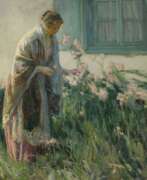

Myron G. Barlow was an American painter and illustrator known for his genre scenes, portraits, and landscapes. He was began his artistic training at the Art Institute of Chicago. Later, he studied at the Académie Julian in Paris, where he was influenced by the Impressionist and Post-Impressionist movements.
Barlow worked as an illustrator for various publications, including Harper's Weekly, Scribner's Magazine, and The Saturday Evening Post. He also taught at the Art Students League in New York City.
Barlow's paintings often depicted everyday life, with a focus on working-class people and their surroundings. His use of color and light gave his paintings a sense of warmth and intimacy.
Barlow was a member of several art organizations, including the National Academy of Design, the Society of American Artists, and the American Watercolor Society. He received numerous awards and honors during his lifetime, including a gold medal at the Panama-Pacific International Exposition in San Francisco in 1915.
Today, his paintings can be found in several museums and institutions, including the National Gallery of Art in Washington, D.C., and the Brooklyn Museum in New York City.


Paul Barthel was a German genre painter and portrait painter. He studied painting from 1877 at the School of Applied Arts in Dresden and then at the Royal Prussian Academy of Arts in Berlin with Julius Ehrentraut and Eugen Bracht.
Paul Barthel worked in Dresden, where he focused mainly on watercolours. In 1922 he settled in Bamberg, where he worked as a restorer.


Nikolai Nikolaevich Baskakov (Russian: Никола́й Никола́евич Баска́ков) was a Russian artist, prominent within the Soviet era's art scene. Born in Astrakhan in 1918, Baskakov was celebrated for his mastery in portraiture and his commitment to the Socialist Realism style, an artistic approach favored by the Soviet Union to propagate ideological values through a realistic depiction of everyday life.
Baskakov's contributions to art are not only marked by his technical prowess but also by his ability to capture the ethos of his time. His works often featured workers, collective farmers, and heroes of the Soviet Union, serving both as artistic and ideological tools. Among his notable works, the portraits of Lenin and other political figures stand out, showcasing his skill in depicting influential leaders with a combination of reverence and realism.
His legacy extends beyond his paintings, as Baskakov was also a respected teacher at the Repin Institute of Arts in Saint Petersburg, where he influenced a new generation of Russian artists. His works are preserved in prestigious galleries across Russia, including the Tretyakov Gallery and the Russian Museum, making them a significant part of Russian cultural heritage.
For collectors and enthusiasts of Soviet art, staying informed about exhibitions and sales of Baskakov’s works is essential. Sign up for updates and exclusive alerts on new acquisitions and auction events featuring Nikolai Nikolaevich Baskakov. Stay connected to a pivotal part of art history.


Thomas Baumgartner was a German painter, recognized for his evocative portrayals of rural life. Born in Munich in 1892, he was celebrated for his detailed and vibrant depictions of Bavarian customs and countryside, earning him a place among notable 20th-century German painters.
After training at the Munich Academy and various travels in Europe, Baumgartner established himself with a distinctive style that blended traditional Bavarian influences with his unique artistic vision. His works often featured robust, earthy scenes of peasant life, which not only showcased his technical skill but also conveyed a deep affection for his homeland's landscapes and customs.
Throughout his career, Baumgartner's paintings were widely exhibited and appreciated, particularly for their craftsmanship and the way they captured the essence of rural Germany. His art is a testament to the cultural heritage of Bavaria, resonating with those who value the preservation of regional histories and lifestyles.
Baumgartner's legacy is preserved in art collections and has been featured in major exhibitions, often commanding attention in both national and international art circles. His dedication to depicting the simplicity and beauty of peasant life helps keep the rural traditions of Germany alive in the collective memory of the art world.
For those interested in exploring the serene beauty of traditional German art, Thomas Baumgartner's works offer a timeless journey into the heart of Bavaria's countryside and culture.
To stay updated on upcoming sales and auctions featuring the works of Thomas Baumgartner, consider signing up for our newsletter. This subscription will keep you informed about new opportunities to acquire pieces from this remarkable artist's legacy.


Mike Bayne is a contemporary Canadian artist creates miniature Photorealist paintings of overlooked North American scenes, frequently of his childhood town. Capturing every detail from his working photographs, he replicates his subject not only in terms of imagery, but often also in scale, by mimicking the size of actual commercially printed photographs. His depictions of architecture and vehicles render environments locked in a moment of time, devoid of people and movement. Visually, his works are at once abruptly realistic, and yet purposefully inorganic. He received his MFA from Concordia University and has participated in many group shows across the U.S. and Canada. His work is in the collection of the National Gallery of Canada, the Art Gallery of Ontario, the Nerman Museum etc. Bayne was also the recipient of the Kingston Prize for Portraiture in 2011.


Peter Hill Beard was an American artist, photographer, diarist, and writer who lived and worked in New York City, Montauk and Kenya. His photographs of Africa, African animals and the journals that often integrated his photographs, have been widely shown and published since the 1960s.
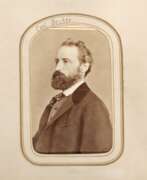

Carl Emil Rudolf Ludwig Becker was a German marine artist.
He was awarded gold medals at the International Art Exhibition of 1894, in Vienna, and the Große Berliner Kunstausstellung of 1896. Three years later, he was one of the co-founders of the Düsseldorfer Künstler-Vereinigung (artists' association). After the turn of the century, marine painting was heavily promoted by Kaiser Wilhelm II, who was attempting to make Germany a major sea power. As a result, the demand for Becker's paintings increased farther inland.


James Carroll Beckwith was an American landscape, portrait and genre painter whose Naturalist style led to his recognition in the late nineteenth and very early twentieth century as a respected figure in American art.


Abraham Adolf Behrman was a Polish artist of Jewish origin, best known for his paintings of Jewish shtetl life in the open air as well as landscapes and group portraits. He spent most of his life in Łódź and was killed during the liquidation of the Białystok ghetto during the Holocaust.


Victoria Markovna Belakovskaya (Russian: Виктория Марковна Белаковская) was a Russian Soviet artist of the mid-twentieth century. She is known as a painter, graphic artist and representative of the Leningrad school of painting.
Victoria Belakovskaya participated in exhibitions of Leningrad artists since the early 1930s. Her work covers various genres, including portraits, genre compositions, still lifes and landscapes. Her famous works include "Pioneer Girl" (1931), "Self-Portrait with a Cigarette" (1936), "Leningrad Landscape" (1953), "Spring Flowers. Still Life" (1961), a series of landscapes of Altai, Crimea, Kiev and others.
Works by the artist are in the collections of museums in Russia, Great Britain, USA, France and other countries.




Piotr Petrovich Belousov (Russian: Пётр Петро́вич Белоу́сов) was a distinguished Soviet and Russian artist, born on May 3, 1912, in Berdyansk, and passed away on March 31, 1989, in Leningrad. He is widely celebrated for his contributions to the Leningrad School of Painting, having been an influential figure in shaping the artistic landscape of the region. His expertise extended across various mediums, including painting, etching, and graphic arts, with a notable focus on themes like the Bolshevik Revolution and historical Soviet figures like Lenin.
Belousov's educational and professional journey was deeply intertwined with the prestigious Ilya Repin Leningrad Institute of Painting, Sculpture and Architecture, where he both studied and later taught, eventually rising to the rank of professor and head of the drawing department by 1956. His career was marked by numerous accolades, including the titles of Honored Artist and People's Artist of the RSFSR, reflecting his significant impact on Russian art and education.
Throughout his life, Belousov participated in many exhibitions and his works are held in high esteem, not only in Russian state museums like the Russian Museum and the Tretyakov Gallery but also internationally. His pieces, particularly those that capture key moments in Soviet history and urban landscapes, remain influential and are sought after by collectors around the worl.
For enthusiasts of Soviet art and collectors interested in Belousov's works, staying updated on exhibitions and sales can provide valuable opportunities to acquire his art. To receive alerts about new product sales and auction events featuring Piotr Petrovich Belousov's works, signing up for updates is highly recommended.
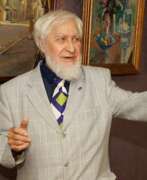

Yuri Vladimirovich Belov (Russian: Юрий Владимирович Белов) was a Soviet and Russian artist of the second half of the twentieth and early twenty-first centuries. He is known as a painter, a representative of the Leningrad school, who worked in the genres of portrait, landscape, still life and historical painting.
Yuri Belov actively participated in exhibitions since 1954. In 1960-1980 the main theme of his work was the images of Lenin and the history of the revolutionary movement. The artist's manner evolved from strict objectivism to a more decorative and impressionistic style.
The master's works are in museums in Russia, France, the USA, Germany and other countries, as well as in private collections.


Alois Bergmann-Franken was an academically trained German painter. In the 1930s he began to become known in the Franconian region through his artistic work in the churches. He mastered the fresco technique, encaustic painting, tempera painting and oil painting. By 1965, he had created over 40 depictions of the Way of the Cross in paintings and mosaics, many frescoes and mosaics in churches in Lower Franconia, oil paintings, watercolours, concrete glass windows, woodcuts and sculptures of the Madonna.




Oscar Edmund Berninghaus was an American artist and a founding member of the Taos Society of Artists. He is best known for his paintings of Native Americans, New Mexico and the American Southwest. His son, Charles Berninghaus (1905–1988), was also a Taos artist.
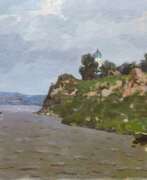

Yakov Tarasovich Besperstov (Russian: Яков Тарасович Бесперстов) was a Russian Soviet artist of the second half of the twentieth century. He is known as a painter, muralist, representative of the Leningrad school of painting.
At the initial stage of his career, Yakov Besperstov worked in the field of monumental and decorative painting, participating in the painting of various buildings. Later he moved to easel painting, creating portraits, genre paintings, as well as urban landscapes. His works were exhibited at exhibitions from the late 1950s and were appreciated by leading artists of Leningrad. The master traveled extensively throughout various regions of Russia and other countries, including France.
His works are in museums and private collections in various countries, including Russia, France, Belgium, Germany, Spain and Italy.


Arne Besser is a contemporary American artist. He received training as an artist at the Art Center School, Los Angeles. There he studied with John Audubon Tyler and Lorser Feidelsson. Beser’s approach to Photo-Realism is to draw from the urban landscape and nature a succinct “set like” image of reality. His city scenes depict New York street life alive with trading and traders, prostitutes and junkies looking for a fix. These visual images iconify the underside of urban life in a way that elevates this point of view to an almost mythic level.
